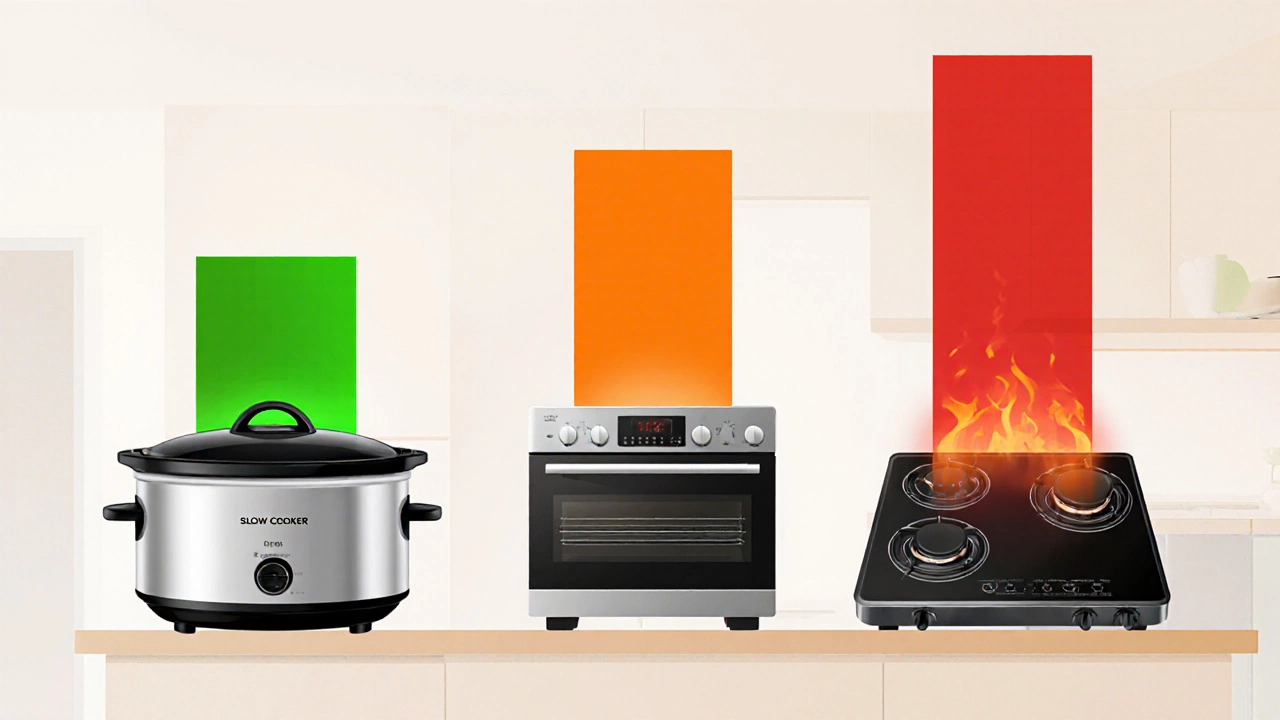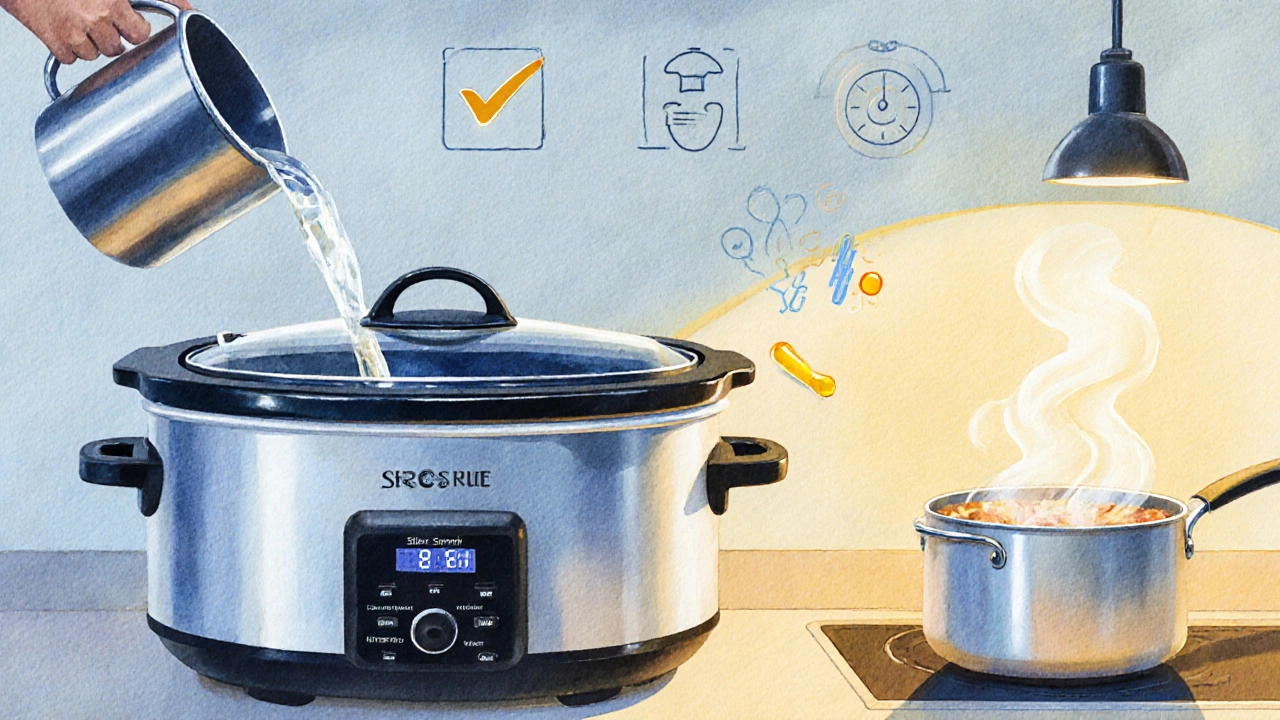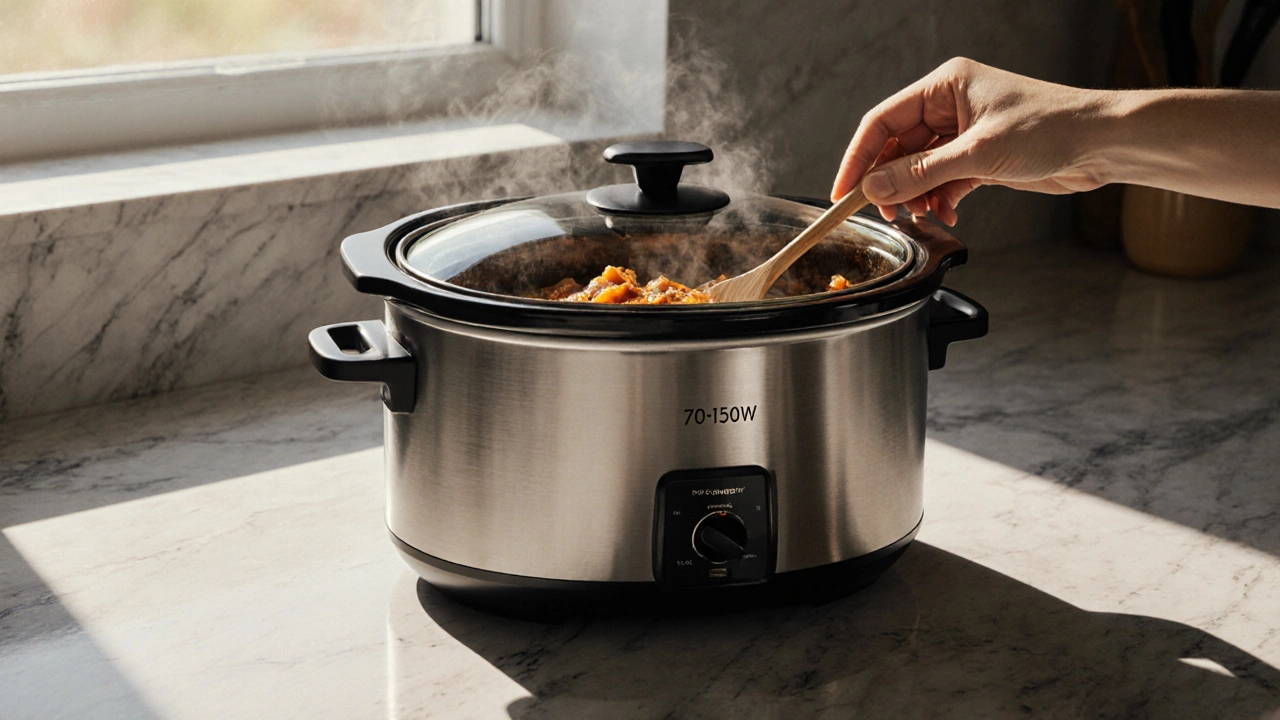Slow Cooker Electricity Cost Calculator
Calculate Your Slow Cooker Costs
Energy Usage
0.00 kWhElectricity Cost
£0.00How this compares to other appliances
| Appliance | Energy Used (kWh) |
|---|---|
| Slow Cooker | 0.80 |
| Oven (2,000W for 1hr) | 2.00 |
| Stovetop (1,500W for 1hr) | 1.50 |
| Microwave (1,200W for 30min) | 0.60 |
Energy-saving tip: Using the 'low' setting instead of 'high' can reduce energy use by up to 50% while still cooking food properly.
Key Takeaways
- Typical slow cookers run between 70W and 150W, far lower than ovens or stovetops.
- One 8‑hour session uses about 0.6-1.2kWh, costing roughly £0.07-£0.14 in the UK.
- Because they cook at low, steady temperatures, they are among the most energy‑efficient kitchen appliances.
- Choosing a model with an automatic shut‑off, a tight‑fitting lid, and a proper size reduces waste.
- Simple habits - like pre‑heating water or using the ‘keep warm’ setting sparingly - shave off extra kilowatt‑hours.
What a slow cooker is and how it works
Slow cooker is a countertop appliance that applies low, steady heat to food over several hours, usually between 70°C and 95°C. It relies on an internal heating element, a sealed ceramic or metal pot, and a thermostat that keeps the temperature within a narrow band. The design lets flavors meld while the appliance draws a small, constant amount of power.
Typical power draw and energy use
The key figure to watch is the watt rating stamped on the back of the unit. Low‑end models sit around 70W, mid‑range around 100W, and larger family‑size units can reach 150W on the high setting. To translate that into electricity cost, multiply the wattage by the hours you run the cooker, then divide by 1,000 to get kilowatt‑hours (kWh):
kWh = (Watts × Hours) ÷ 1,000
For a 100‑W cooker on a 8‑hour low setting:
kWh = (100 × 8) ÷ 1,000 = 0.8kWh
In the UK, the average residential price of electricity in 2025 is about £0.18 per kWh. That single pot of stew costs roughly £0.14 - well under a pound.

How slow cookers stack up against other cooking methods
| Method | Avg Power (W) | Typical Session (hrs) | Energy Used (kWh per session) |
|---|---|---|---|
| Slow cooker | 100 | 8 | 0.8 |
| Oven | 2000 | 1 | 2.0 |
| Stovetop | 1500 | 1 | 1.5 |
| Microwave | 1200 | 0.3 | 0.36 |
Even when you add a 30‑minute pre‑heat or a brief ‘keep warm’ period, the slow cooker still uses less than half the energy of an oven for a comparable roast.
Real‑world cost per use
Let’s run a quick example. Imagine you make a chicken curry that needs 6hours on low (70W). Energy used: (70 × 6) ÷ 1,000 = 0.42kWh. At £0.18/kWh, the electricity cost is £0.08. Compare that to a roast that might require a 2‑hour oven bake at 2,000W - that’s 4kWh or £0.72 of electricity.
These numbers show why many households schedule bulk meals in the slow cooker: the energy price per dinner drops dramatically.
Tips to squeeze even more efficiency out of your slow cooker
- Pick the right size: A pot that’s too large for the volume forces the heating element to work longer, raising kWh.
- Don’t lift the lid: Each opening releases heat; the cooker then draws extra power to recover the temperature.
- Use the ‘low’ setting whenever possible: Low draws about half the wattage of high, yet most recipes still finish in acceptable time.
- Pre‑heat liquids on the stove before adding them; the cooker reaches the target temperature faster.
- Take advantage of the automatic shut‑off feature. If you’re cooking for a short window, switch to ‘warm’ after the main cycle.
- Maintain a tight seal: A well‑fitted lid prevents steam loss, keeping the inside hot without extra power.

Choosing an energy‑efficient model
When you shop, look for the following attributes (usually listed on the product label or in the manual):
- Power rating: 70W-100W on low is ideal for most families.
- Programmable timer: Allows you to start cooking just before you’re home, eliminating unnecessary “keep warm” hours.
- Insulated ceramic insert: Better heat retention means the element can stay off longer.
- Energy‑star or equivalent certification (where available in Europe).
Brands that consistently hit low‑watt targets include Crock‑Pot (the 4‑quart Classic), Instant Pot (the slow‑cook function), and Morphy Richards (the ‘Slimline’ range). Check the specification sheet for exact wattage before you buy.
Frequently Asked Questions
How many watts does a typical slow cooker use?
Most household models range from 70W on the low setting to 150W on high. The exact figure is printed on the back of the unit.
Is a slow cooker cheaper to run than an oven?
Yes. A typical 8‑hour slow‑cook cycle uses about 0.8kWh, while a 1‑hour oven bake can consume 2kWh or more, making the oven roughly three times more expensive per session.
Can I use a slow cooker to save on my electricity bill?
Absolutely. By replacing occasional oven roasts or stovetop stews with slow‑cooked meals, you can shave a few pounds off your monthly electricity cost, especially if you batch‑cook for the week.
Does the ‘keep warm’ function waste a lot of electricity?
The warm setting usually runs at 30-40W, so even an extra two hours only adds about 0.06-0.08kWh (≈£0.01). It’s a small price for food safety.
Should I pre‑heat the slow cooker before adding ingredients?
Most experts advise against it. The cooker is designed to bring everything up to temperature gradually, which is part of the energy‑saving process.
Next steps
If you already own a slow cooker, run a quick test: note the wattage, set a timer for 8hours on low, and check your electricity meter before and after. The difference in kWh tells you exactly how much you’re spending.
Planning a new purchase? Compare the power ratings and look for insulated pots and programmable timers. A modest extra upfront cost often translates into lower bills over the appliance’s life.
Happy cooking - and enjoy those savings while your meals simmer gently.

